Picture a symphony, each instrument synchronised flawlessly, a perfect harmony if you will, creating a masterpiece that captivates the soul. Think of your body in a similar way, an orchestra, with its various systems and organs acting like different instruments; the circadian rhythms being the ones orchestrating it all. These 24-hour internal clocks are deeply rooted in nature and are essential for maintaining our overall health and well-being. So let’s explore what it is, what it does, how it functions and how crucial it is for us to maintain a healthy circadian rhythm for our day-to-day life.
What exactly are circadian rhythms?
Circadian rhythms are the physical, mental, and behavioural changes that we experience over a 24-hour cycle. The word circadian itself is comprised of the Latin words ‘circa’ meaning ‘about’ and ‘dies’ meaning ‘day’, so circadian simply translates to ‘about a day’. It is influenced by physical activity, stress, eating habits, temperature and the social environment among other things, but light and dark affect it the most. However, it is not exclusive to us humans alone, in fact, most living organisms, ranging from plants and animals even including microorganisms, have circadian rhythms. It is, and it has been for a very long time, an integral part of life, here on Earth.
Scientific endeavour
Changes in the behaviour of organisms with the time of the day is something that most of us have observed to a certain extent, be it the closing of the leaves of the mimosa plants (ex: Touch-me-not) at night, or the movement of the sunflower in accordance with the path of the sun. Many such observations have been documented for a long time and are commonly agreed to have begun with plants. In 1729, the French scientist Jean-Jacques d’Ortous de Mairan conducted an experiment with the aim of distinguishing an endogenous clock from responses to daily stimuli. He placed a mimosa plant in the dark and observed that it still closed and opened rhythmically at the appropriate time of the day (sunset and sunrise), suggesting the existence of an internal clock.
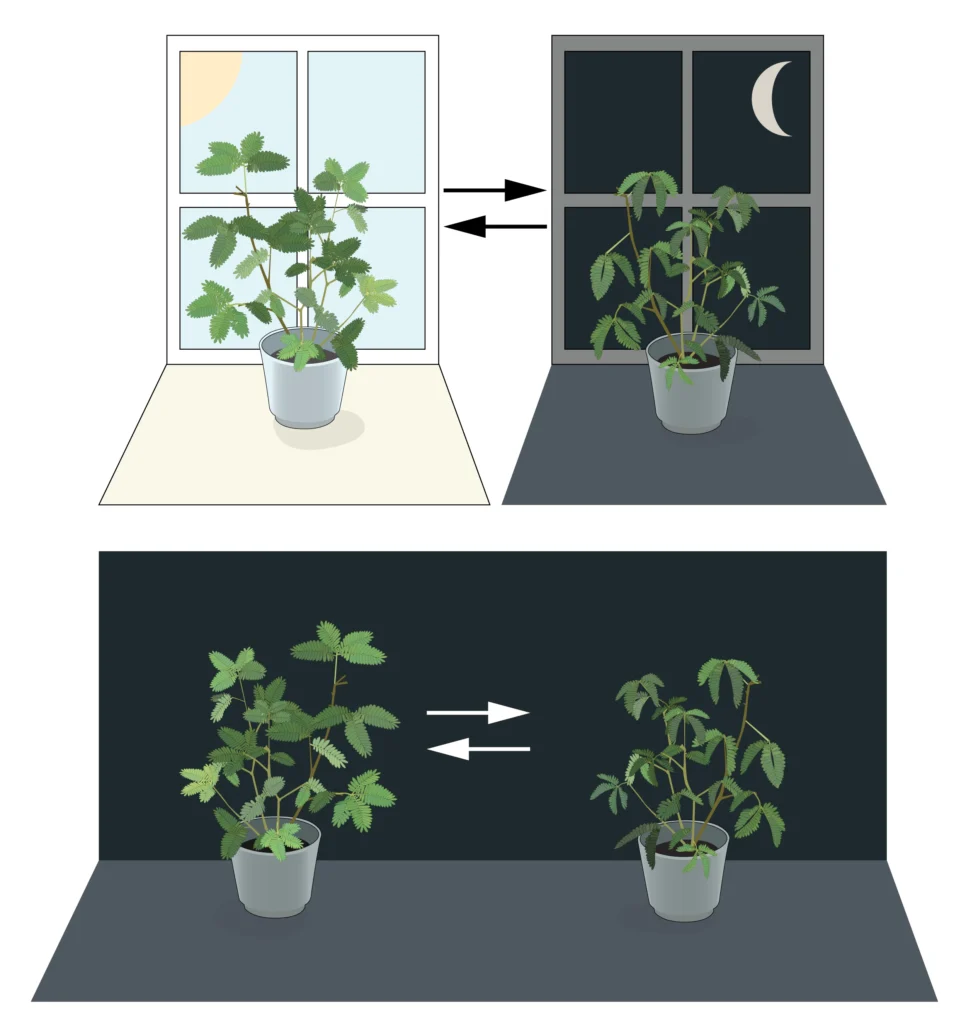
Another such experiment was conducted 2 centuries later, by a German biologist named Erwin Bünning. He put a bean plant under constant light conditions not only observing the existence of an endogenous rhythm but also showing the inheritability of such rhythms even if the parent plants were exposed to non-natural light conditions. This intrigued the scientific community and the question of the existence of such a clock was debated for decades.
It wasn’t until the work done by Seymour Benzer and his student Ronald Konopka during the early 1970s, that we progressed from purely behavioural observations to forming a genetic basis of circadian rhythms. Unlike several geneticists at the time, Benzer believed that the actions of single genes could influence specific behaviours. Benzer and Konopka chose fruit flies (Drosophila melanogaster) as the subject of their studies and managed to isolate 3 different strains of mutant flies showing alterations in the normal 24-hour cycle. One was arrhythmic (no rhythm), the second was a short-period mutant (19 hours) and the third with a longer period of 28 hours. Further tests (including cross-breeding) suggested that these variations were caused by the mutation of the same gene, later named period. This discovery provided the first genetic link to circadian rhythms, revolutionizing the field. It established that circadian rhythms are not merely behavioural or physiological responses but are genetically encoded at the cellular level, sparking decades of research.
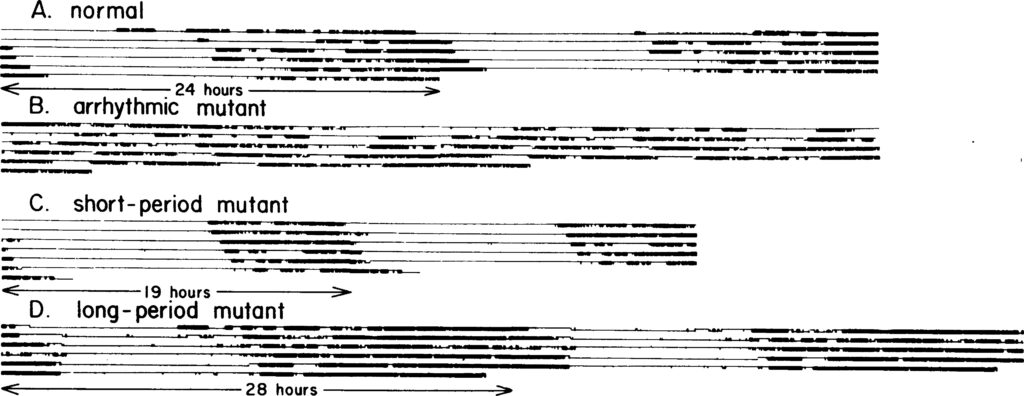
The field was propelled further by Jeffrey Hall and Michael Rosbash, who went on to discover that PER, the protein encoded by period, accumulated during the day and was degraded during the night, oscillating over a 24-hour cycle. The answer to the question of how came in the form of timeless, a gene encoding the TIM protein discovered by Michael Young. He showed that as night fell, TIM bound directly to PER, entering the nucleus and stopping the cell from making additional PER. Then as the day breaks, the PER-TIM complex breaks down, lifting the block and thence, the cycle repeats. This essentially forms a feedback loop with the frequency of oscillations controlled by doubletime gene encoding the DBT protein, adjusting it to more closely match a 24-hour cycle. For their discoveries of the molecular mechanisms controlling the circadian rhythm, the 3 scientists were jointly awarded the Nobel Prize in Physiology or Medicine 2017.

What we know so far
In us humans, nearly every cell and organ has its own individual clock known as a peripheral clock that regulates cellular activities. These peripheral clocks are in turn governed by a master clock, the suprachiasmatic nucleus (SCN), that exists in our brains. The SCN receives light input from our retina, allowing it to sense the day-night cycle and adjust the cellular clocks accordingly. Along with the input from the SCN, the synchronization of the peripheral clocks is also affected by our physical activities, feeding, temperature etc. Thus, the circadian system of an organism resembles a web of interconnected clocks rather than a single clock.
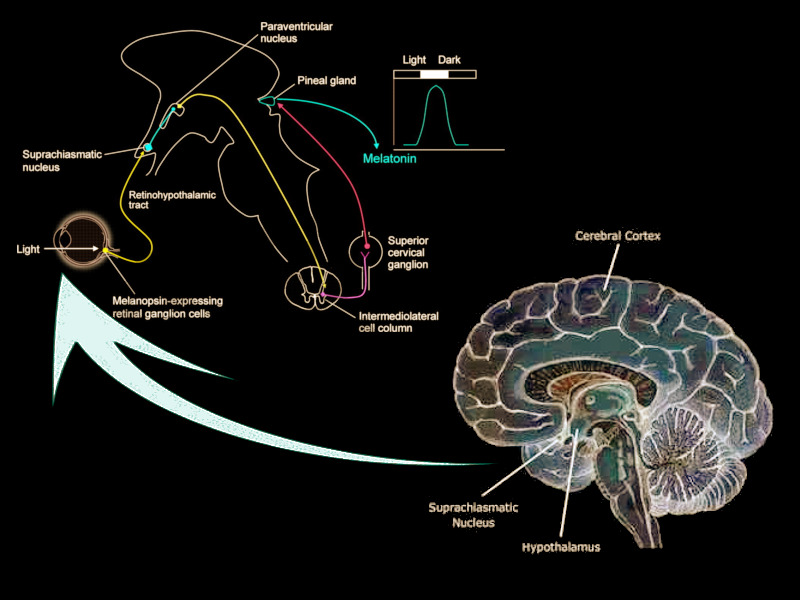
One of the major functions of SCN is its indirect control over our sleep-wake cycle. As evening approaches, the decreasing light signals received by the SCN trigger the release of melatonin, inducing sleep. Similarly in the morning, the SCN halts the production of melatonin and triggers the release of cortisol and other hormones to wake us up. This, along with its effect on other essential physiological functions such as temperature regulation, feeding behaviours and hormone release, helps SCN keep our entire system in sync with the external environment.
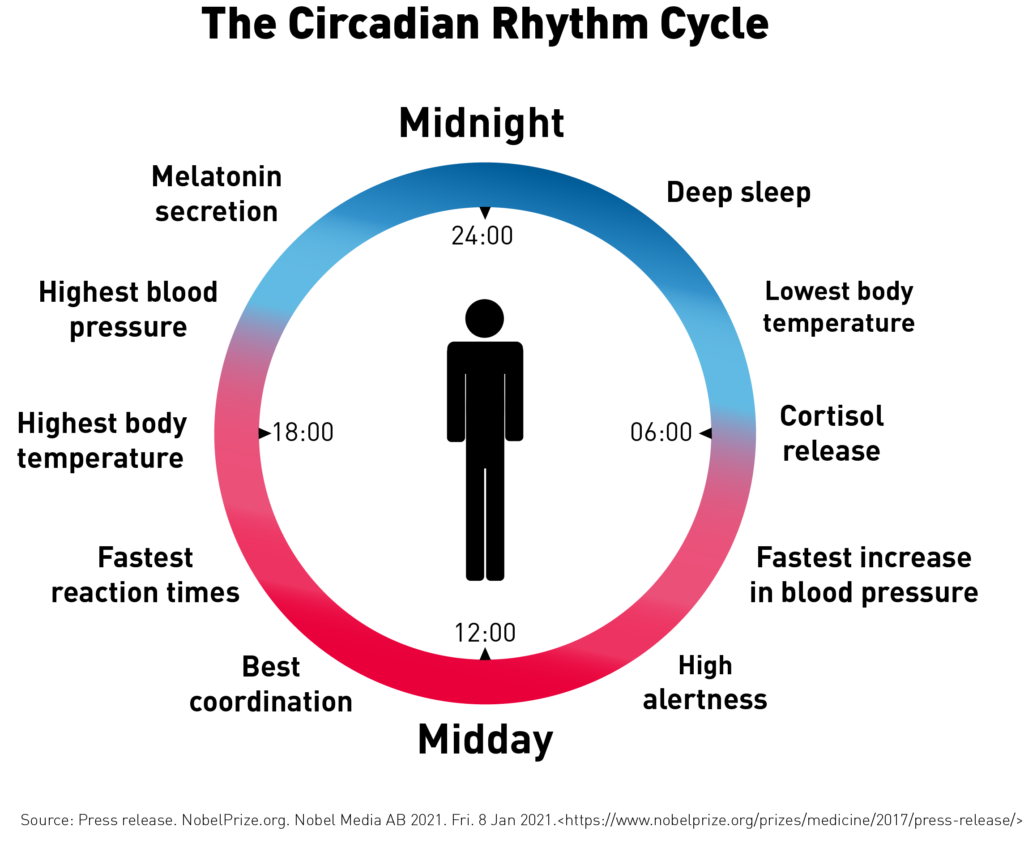
Impact on human health
As discussed earlier, circadian rhythms affect various physiological functions of our body, and as such, having a routine that is not aligned with it can result in a number of health problems such as arrhythmic production of hormones, sleep disorders, poor cognitive functions, bad memory formations, including mood disorders such as depression, anxiety, bipolar disorders, as well as some neurological diseases. An example of a temporary disruption could be jet lag which occurs when your body’s circadian rhythm is out of sync with the time zone you are in, which confuses your body leading to short-term effects such as fatigue, poor concentration, headaches, difficulty with focus and loss of appetite. These symptoms go away once your internal clocks synchronise with the external.

On the other hand, long-term disruptions such as working night shifts, or those caused by neurological diseases such as Alzheimer’s disease, would cause lasting health problems ranging from metabolic disorders such as obesity or type 2 diabetes to depression, anxiety, heart and blood pressure problems, gastrointestinal issues, including an increased risk of cancer.
Maintaining a healthy circadian rhythm
A well-synced circadian rhythm is key to optimizing various aspects of health. It supports our immune systems and helps regulate blood pressure. Studies show that regular circadian rhythms are associated with better mental clarity, boosting focus and problem-solving activities resulting in increased productivity and improved decision-making skills. As such, maintaining a healthy circadian rhythm becomes very important, which can be done by putting a few habits into practice such as:
1. Light exposure: Start your day with exposure to natural light. Go for a walk or simply stand outside, bathing yourself in the morning sunlight. This helps reinforce your internal clock, aligning it perfectly with the environmental cues. Also, reduce your exposure to blue light from the screens at night. It can interfere with the production of melatonin, delaying sleep onset.
2. Consistent sleep schedule: Nothing strengthens the body’s natural rhythm like a routine repeated daily. Aim to go to bed and wake up at the same time each day, even on holidays. This will help you in getting better sleep and waking up feeling refreshed the next day.
3. Mindful eating: Eating earlier in the day aligns better with the patterns of circadian metabolism. Avoiding large meals close to bedtime and eating earlier supports digestion and helps in regulating blood sugar.
4. Physical activity: Exercise is beneficial for health, but doing it too close to bedtime can disrupt sleep. Therefore, similar to meals, physical activities are best done during daylight hours.
Conclusion
The circadian rhythms are an important aspect of our health and wellness yet we often overlook it. It’s not just about improving sleep, but it’s about enhancing every aspect of our health, from mental clarity and emotional resilience to long-term physical well-being. By aligning our daily routines with our natural biological clock, we can give ourselves the best shot at a vibrant and fulfilling life. To quote the Nobel laureate Michael Rosbash himself: “There are no controlled experiments in life. Life is a one-shot deal.” So support your circadian rhythm with healthy lifestyle choices and work with it, not against it.
Reference/s:
- de Mairan, J. (1729). Observation botanique. Hist. Acad. Roy. Sci. 35–36.
- Ronald J. Konopka, Seymour Benzer (1971). Clock Mutants of Drosophila melanogaster
- https://www.nobelprize.org/prizes/medicine/2017/advanced-information/
- https://www.nigms.nih.gov/education/fact-sheets/Pages/circadian-rhythms.aspx
- Neuroanatomy, Nucleus Suprachiasmatic
- Circadian rhythm disruption and mental health
- https://www.health.harvard.edu/blog/why-your-sleep-and-wake-cycles-affect-your-mood-2020051319792
- Circadian physiology of metabolism

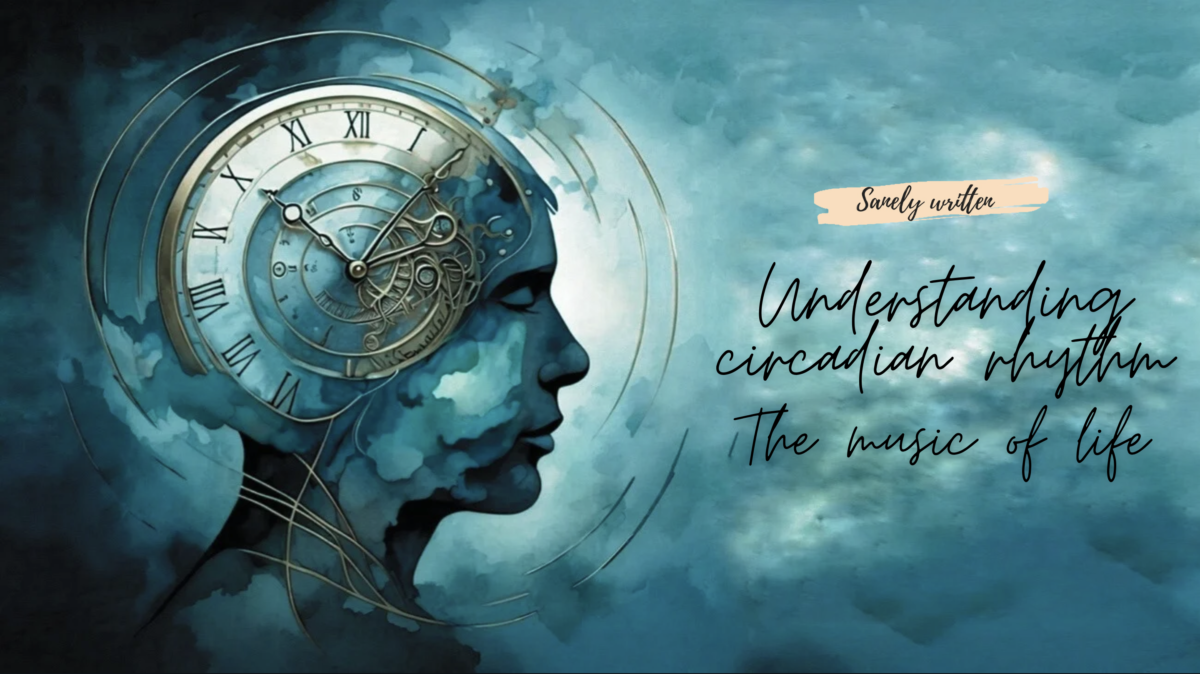


One reply on “Understanding circadian rhythm: The music of life”
Very Informative. Thanks for such a detailed explanation.